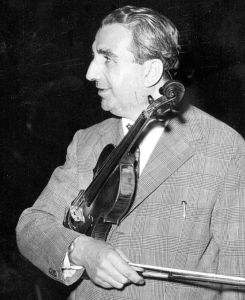Violinist
On 14th May 1902 Aldo Ferraresi, violinist, was born in Ferrara. His father Augusto, an artillery marshal and a passionate mandolinist, and his mother Marcella Jesi, availing themselves of the child's musical talents, started him at the age of 5 to study the violin at the Istituto Musicale Frescobaldi in Ferrara, with the talented masters Federico Barera and Umberto Supino.
At the age of twelve he entered the conservatory of Parma and at the age of 15 he graduated in violin at the Accademia di Santa Cecilia in Rome.
He began his concert career at the Liceo Musicale in Bologna, at the Teatro Comunale and at the Teatro Verdi in Ferrara, a career of "enfant prodige" with a daring and informal spirit, characteristic of his whole life. In Ferrara, when he was very young, he performed at the Apollo cinema, in the silent cinema orchestras, in the concert cafés in Viareggio and Florence ("Orchestra Ferraresi-Cortopassi"). Later he went to Brussels to the school of the famous violinist Eugène Ysaye, who considered him the best of his students.
His career as a soloist was brilliant from the very beginning: "he, although fifteen years old, is already a perfect violinist, an excellent connoisseur of the technique of his instrument and possesses a very sensitive musical temperament that allows him to interpret even the most difficult masters in an impeccable way" (Bastianelli in Il Resto del Carlino, 1918).
Nazi-Fascism and the Pesaro war on the Ferrarese also due to the fact that his mother was of Jewish religion.
His activity took place from the Teatro alla Scala in Milan, to the Royal Festival Hall in London, to concerts in Spain, Germany, Switzerland, Russia, Portugal, Yugoslavia, United States, where he was invited to celebrate the anniversary of the Philadelphia Orchestra; everywhere with the most famous conductors, Scherchen, Knappertsbusch, Munch, Barbirolli, Rodzinski, Celibidache, Klecky, Martinon, Cluytens, Poulet, Erede, Rossi, Zecchi, Sonzogno and many others.
In '32 he was called to Sanremo by Franco Alfano to be part of the "Quartetto di Sanremo", a complex formed not only by him, but also by Ernesto Nicelli, Romeo Scarpa and Carlo Rampi, later joined by the pianist Marco Martini, a complex destined to be a great success. In 1934 he took up residence in Sanremo.
After the Second World War, on June 14th 1948, Ferraresi returned to the podium at the Teatro alla Scala in Milan, conducting André Cluytens in the very difficult Concerto for violin and orchestra by Mario Guarino.
Two concerts were memorable for him, the first in Genoa for the celebration in 1950 of the 5th Centenary of the birth of Christopher Columbus, where he performed Paganini's Concerto in D major on the Guarnieri "Cannone" and in 1965 the concert in the Vatican, in the Sala delle Benedizioni, in the presence of His Holiness Pope Paul VI (to whom he had given violin lessons years earlier) and the Papal Curia, in which he played the Solemn Melodies op.77 by Jean Sibelius.
No less important was the 1950 concert at the Astra Theatre in San Remo in the presence of Prince Philip of Edinburgh, when he had to repeat Paganini's Concerto in D major.
In 1963 he performed Aram Kaciaturian's Concerto for violin and orchestra, broadcast on RAI, under the direction of the composer himself.
But Ferraresi never neglected chamber music, which he held in great consideration: first violin of the San Remo Quartet and the San Remo Symphony Orchestra, then first violin soloist at the San Carlo Theatre in Naples.
Among the pianists who accompanied him we will remember Antonio Beltrami, Riccardo Castagnone, Ernesto Galdieri and his son Augusto Ferraresi.
He died on June 28th 1978 from a sudden and incurable illness, in that San Remo which had seen him a successful protagonist; he had recently moved there from his residence in Naples; he was buried in the Ospedaletti cemetery next to the tomb of his mother and a brother
.
He played on many precious violins, for example the Stradivari "King George" and the Guarnieri di Paganini, but his favourite instruments were a Camillo Camilli and an Alessandro Gagliano which he often used in his recordings.
(source: Marco Mauro)





